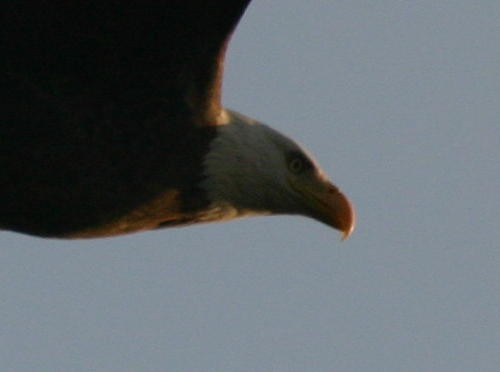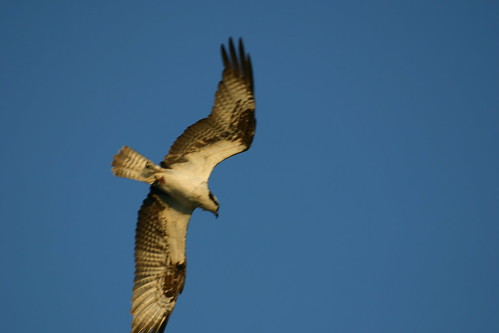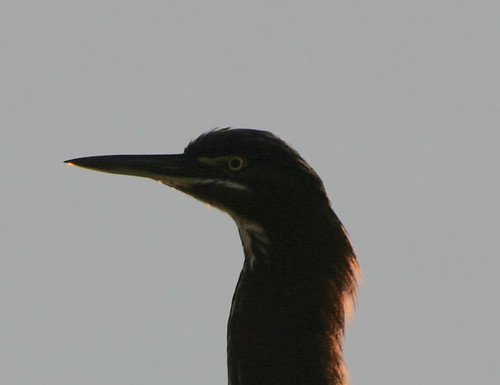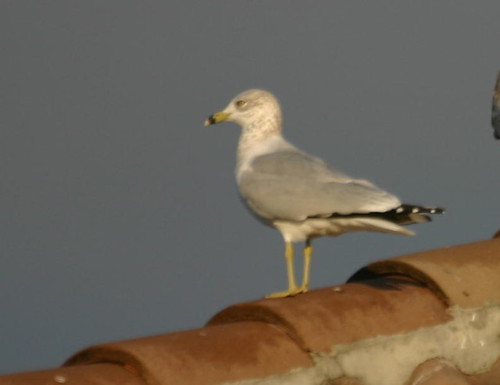In prior years, we occasionally saw Bald Eagles flying over our small Florida lake. Once I saw one attack an Osprey that had just caught a fish. The eagle’s larceny attempt was not successful. However, this year the eagles have paid us several visits (see Double Eagle and The Eagle Has Landed). There is now evidence that they may be breeding within a few miles of us. At least twice, adult Bald Eagles have been observed carrying sticks to a possible nest site. So far, none of my neighbors has seen the actual nest. This morning, during a feeding frenzy that attracted about 5 Ospreys, a couple dozen Ring-billed Gulls, Double-crested Cormorants and several heron species, an eagle suddenly appeared. It flew directly overhead, only about 20 feet high.

Luckily, I was prepared to photograph it because of a dramatic bird “happening” that made me run for my camera. Just a few minutes earlier, only about 10 feet off our waterfront, an Osprey caught a very large fish and was unable to lift it out of the water. I heard the loud splash and at first, when I looked, I thought I was seeing a cormorant. The “cormorant” morphed into a breast-stroking Osprey. It appeared to be my chance to capture an Osprey’s demise. It actually sunk underwater and was struggling to get the front part of its body and wings up. During the 20 seconds that it took for me to grab the camera and switch to a long lens, the Osprey apparently was able to let go of the fish, as I saw it flying away empty-clawed, vigorously shaking off the water.

In the harsh early morning backlight, I photographed this Tricolored Heron at our lawn-lake interface. It paid me little heed.

A Little Blue Heron joined the Tricolored. They were attracted by the activity of many small fish along the lake margin, perhaps herded there by a cormorant feeding just offshore.

Then, a Green Heron walked right up, next to the other two herons.

A Ring-billed Gulls, crop full of fish, sat on a nearby rooftop.

It’s said that South Florida has only two seasons, the hot and wet Hurricane Season and the pleasant and dry Snowbird Season. Actually it is not as boring as that. Much of nature responds to the length of days quite independent of this arbitrary classification. As in temperate climes, spring and fall songbird migration occurs on schedule, and can even be spectacular, between Florida and Cuba (during migration, check the Key West radar link in the column to the left).
The rear of our home faces east, overlooking the lake. As we enter our fourth year of living here, we are already sensitive to the rhythm of the seasons. In summer, the sun rises to our northeast and bears down heavily until noon, when our back patio mercifully begins to gather shade. Blinds are drawn early, and the air conditioning goes into overdrive. Sunrise shifts southward until the first day of winter, when windows stay open day and night. In early March the Giant or Cane toads (Bufo marinus, pictured, from floridagardener.com) anticipate spring with strangely mechanical calls that resemble distant lawn mowers or diesel generators. Soon their black tadpoles crowd the lake margins. The cycle is predictable.

Our 10 acre lake also undergoes cycles, but they seem less predictable. The water is usually clear and tinted like weak tea. Storm runoff may roil it a bit and increase its turbidity for a few days. However, at intervals the lake undergoes a massive transformation. Gobs of green algae suddenly appear on the surface and drift to accumulate on the leeward shores. At the same time, flocks of Ring-billed Gulls, sometimes accompanied by Caspian and Least Terns, suddenly appear. For a few days they participate in a feeding frenzy. After a few days their numbers diminish, and the lake surface is again clear.
This phenomenon, called “turnover,” is caused by the mixing of the lake’s cool and warm layers. I think there were rather subtle turnovers around Thanksgiving the past two years, when cool evenings and gentle fall rain lowered the temperature of the normally warm water near the lake’s surface. As it cools, the density of the upper layer becomes greater than that of the warm water underneath. At some point, the density reaches a critical level and the cool water sinks downward, displacing the warm water that now floats upward, carrying with it the green stuff from the lake bed. The fish that depend upon the vegetation for food and shelter now are distributed more evenly, and become more vulnerable to predators all the way up the food chain.
Up north, and even in our small backyard ponds in New Mexico, turnovers are much more dramatic and predictable, occurring both in spring and fall. Very deep lakes may turnover less frequently as a larger volume of cool water (whether from surface cooling in the fall or spring runoff from snow melt) is required to push up the warm water. Surface action (due to wind-caused waves) in smaller lakes may hasten mixing and “turnover.’
Here in Florida these less dramatic “turnovers” seem to happen at irregular intervals. In late November, following a string of cool nights, with little rain, the lake changed again. This time there was a significant fish kill, mostly Largemouth Bass and Black Tilapia. The water still appears turbid, and sometimes the fish come to the surface, gasping for air. Maybe it is not proper to call this phenomenon a “turnover.” Perhaps the stale lake water is just not being replaced because of the lack of rain. Right now the major source of the water running into our lake seems to be runoff from lawns, full of fertilizers, insecticides and weed-killers. The source of the water is the lake itself—we suck it up directly for our irrigation, and neighbors who do not live on the lakefront get theirs from shallow wells that likely communicate with the surface water.
In any event, here in South Florida I cannot discern as clear a schedule as I have noted in New Mexico, where fall and spring turnovers seemed quite predictable. Whatever the pattern, turnover attracts all the seasonal species of fish-eating birds, from Anhingas and Double-crested Cormorants to Ospreys and herons of many kinds. Wood Storks and Ibises (White and sometimes Glossy) have concentrated on our lake during previous turnovers—and, I’ve caught a few nice fish myself!

This morning, while I was photographing a large-mouthed fish that was gasping for air, a Tricolored Heron took flight and almost ruined my shot.












